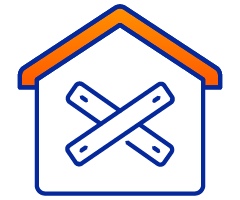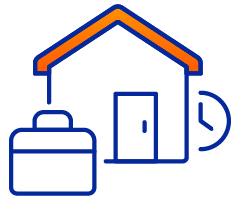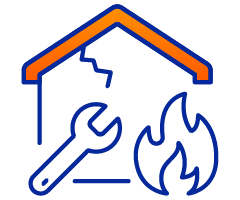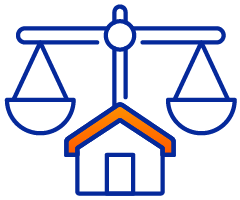Start Here
Homepage Bottom Form
We will get back to you as soon as possible.
Please try again later.
Fire Recovery Binder Checklist
📘 How to Build a Fire Recovery Binder
Created by House Fire Solutions – Helping Homeowners Rebuild with Confidence
A
Fire Recovery Binder is your command center after a fire — a single place where every document, receipt, contact, and photo you need for recovery and reimbursement lives.
Use this checklist to build, organize, and maintain your binder step by step.
🧾 1. Choose Your Binder and Setup
☐ Select a
durable, waterproof, fire-resistant binder (2–3 inches thick).
☐ Use
sheet protectors for all documents to prevent further damage.
☐ Get
dividers or labeled tabs for each recovery category.
☐ Use a
zippered binder or portable case for on-the-go use.
☐ Keep an extra
USB flash drive or
digital backup folder inside.
☐ Add a
cover label: “FIRE RECOVERY BINDER – [Your Last Name, Property Address].”
💡 Tip: Create both a physical binder and a digital version (scanned copies in cloud storage).
🏠 2. Section One: Insurance Policy & Claim Documents
☐ Copy of your
homeowners’ or renters’ insurance policy (full version, not summary).
☐
Claim number, adjuster’s name, and contact information.
☐
Public adjuster contract (if applicable).
☐
Claim correspondence log – printed or handwritten.
☐
Letters, emails, and claim summaries from your insurance company.
☐
Photos and notes from your initial adjuster inspection.
☐ Copies of
Proof of Loss forms,
estimates, and
payment letters.
☐
Insurance coverage breakdown (dwelling, personal property, ALE, debris, etc.).
☐
Reimbursement tracking sheet for payments received and pending.
💡 Tip: Keep sticky notes or a running list of claim issues or unresolved items in this section.
📸 3. Section Two: Damage Documentation
☐
Before-and-after photos of every room and item.
☐
Video walk-throughs (QR code link or USB drive).
☐
Date-stamped images for insurance proof.
☐
Contractor damage assessments or inspection reports.
☐
Smoke and water damage notes (include HVAC, roof, and structure).
☐
Environmental reports (asbestos, soot, or chemical residue).
💡 Tip: Keep digital versions of all photos on a USB drive stored inside the binder.
🧰 4. Section Three: Repairs, Contractors, and Restoration
☐
Fire restoration company contracts and business cards.
☐
Repair estimates (itemized by contractor or company).
☐
Work authorization forms signed by you and contractors.
☐
Receipts and invoices for all restoration work.
☐
Contractor license and insurance certificates.
☐
Inspection reports (structural, electrical, HVAC, plumbing).
☐
Permits and approvals from local building authorities.
☐
Timeline tracker for project milestones and completion dates.
💡 Tip: Add a “Red Flag” page for delays, disputes, or unresponsive contractors.
🧍♀️ 5. Section Four: Additional Living Expenses (ALE)
☐
Temporary housing contracts (hotel, Airbnb, or rental lease).
☐
Receipts for lodging, meals, gas, and laundry.
☐
Invoices for pet boarding, storage units, or transportation.
☐
Copies of reimbursement requests submitted to insurance.
☐
ALE claim summary showing approved and pending payments.
☐
Notes on communication with adjuster regarding ALE extensions.
💡 Tip: Organize receipts by date — it makes claim reconciliation easier.
🛋️ 6. Section Five: Personal Property Inventory
☐
Master inventory list (room-by-room).
☐
Photos of damaged or missing items.
☐
Original receipts or credit card statements for proof of purchase.
☐
Online price comparisons or replacement value estimates.
☐
Item condition notes (Destroyed / Smoke Damage / Salvageable).
☐
Personal property claim form copies.
☐
Total value summary (before and after replacements).
💡 Tip: Keep a printed and digital version of your Home Inventory Form (Before & After Fire) here.
📂 7. Section Six: Financial & Legal Documents
☐
Mortgage documents or lender correspondence.
☐
Deeds, titles, and property tax statements.
☐
Loan payment deferment or hardship requests.
☐
Bank statements showing emergency withdrawals.
☐
FEMA or SBA disaster loan documents.
☐
Receipts for filing fees, notarizations, or legal consultations.
☐
Insurance policy renewals or updates made post-fire.
💡 Tip: Mark any time-sensitive deadlines with colored tabs.
📞 8. Section Seven: Contacts & Communication Log
☐
Insurance adjuster and supervisor contacts.
☐
Public adjuster or claims consultant.
☐
Fire restoration contractor and project manager.
☐
City inspector, building department, and permit office contacts.
☐
Mortgage company representative.
☐
Utility providers (gas, water, power) for reconnection.
☐
Emergency response contacts (fire marshal, Red Cross, etc.).
☐
Neighbors or family assisting during recovery.
☐
Communication log (calls, emails, and in-person meetings).
💡 Tip: Include a “Quick Contacts” sheet in the binder’s front pocket.
🧾 9. Section Eight: Expense & Reimbursement Tracking
☐
Expense log for all purchases and transactions since the fire.
☐
Copies of every receipt and payment confirmation.
☐
Insurance payment tracker for advances, partials, and final settlements.
☐
Spreadsheet of total claimed vs. reimbursed amounts.
☐
Notes on denied claims or appeals submitted.
💡 Tip: Use color codes (🟩 reimbursed, 🟨 pending, 🟥 denied) for clarity.
📜 10. Section Nine: Official Correspondence & Letters
☐
Letters or emails from your insurance company.
☐
Contractor proposals and responses.
☐
Letters from mortgage lender or HOA.
☐
Government assistance communications.
☐
Insurance claim acknowledgment and closure letters.
☐
Policy update notices post-fire.
💡 Tip: Print digital letters and file them chronologically for quick reference.
📚 11. Section Ten: Recovery Notes & Personal Reflections
☐
Timeline of major milestones (fire date, claim filing, move-out, rebuild).
☐
Lessons learned – what worked, what didn’t.
☐
Names of trusted professionals or helpful organizations.
☐
Photos of progress and recovery.
☐
Personal journal entries for emotional recovery.
💡 Tip: Reflection pages can also help if you’re ever asked to testify or verify details later.
🔁 12. Section Eleven: Digital Backup
☐
USB flash drive or
external hard drive copy of all documents.
☐
Cloud storage folder (Google Drive, Dropbox, OneDrive, etc.).
☐
Scanned PDFs of every binder section.
☐
Password-protected access shared with a trusted person.
☐
Quarterly backup reminder added to your calendar.
💡 Tip: Store digital backups in your Fireproof Storage & Document Safety Guide setup.
🧠 13. Section Twelve: Ongoing Maintenance
☐ Update binder whenever you receive new claim updates or payments.
☐ Archive completed sections once repairs are finished.
☐ Review the binder every 3–6 months for accuracy.
☐ Add new emergency contact info and updated insurance documents.
☐ Keep a summary page of what’s left to do in recovery.
💡 Tip: Treat this binder as your ongoing roadmap — not just a temporary file.
✅ 14. Final Homeowner Action Steps
☐ Label and store your Fire Recovery Binder in a
safe, accessible location.
☐ Keep a
digital duplicate in secure cloud storage.
☐ Share access with your
insurance adjuster or recovery consultant if needed.
☐ Review binder contents annually to ensure readiness for future emergencies.
☐ Consider making a smaller
Emergency Evacuation Folder with your most essential pages.
💡 Remember: Organization equals power — and your binder is the foundation of your recovery.
Our Team Helps You Navigate Insurance, Restoration, and Rebuilding
It is a long established fact that a reader will be distracted by the readable content of a page when looking at its layout.

Board-Up
Our Network of Board Up Specialist Will Secure your property fast

Temp Housing
We'll Help You Find Safe Shelter while you recover

Public Adjusters
Our Network of Fire Damage Adjusters Will Fight Help for a fair insurance payout

Investors
Our Partner Specializes in Buying Fire Damaged Homes So you Can Sell your home as-is

Content Cleaning
Restore what matters most

Restoration
Bring your home back to life

Attorneys
We have a network of Protect your rights and claims

Mental Health
Support for you and your family
Want To See If We Can Help You
If you'd like to speak with us today about purchasing Social Security, Personal Injury, Workers' Compensation or Employment Law Leads.
Homepage Bottom Form
We will get back to you as soon as possible.
Please try again later.